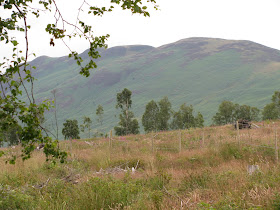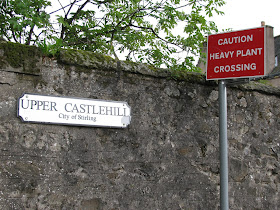My son, I tell thee soothfastie,
No gift is like to libertie;
Then never live in slaverie.William Wallace as taught by his uncle.
It's all for nothing if you don't have freedom.Mel Gibson as William Wallace in Braveheart.
The problem with Scotland, is that it is full of Scots.Edward I in Braveheart.
The Scots have a long history of quarreling and fighting among themselves but they don't lie down quietly for outside invaders. This lesson could have been learned from the Romans who had a brief foray into Scotland but withdrew and built
Hadrian's Wall to keep the "barbarians" in the north where they belonged. Outside of Culloden, no other place in Scotland more represents the Scots' determination to be free than Stirling.
Stirling is not an exceptionally beautiful or rich place. It is strategic. The River Forth, or Firth of Forth - I love to say that name - cuts across Scotland east to west. To control the Highlands in medieval times an invader had to get across the river, and putting an army across the river required a bridge. Happens the Romans built a bridge at Stirling and this was the main point an army could cross into northern Scotland. Farther west than Stirling was too marshy. Secondly, a volcanic crag with sheer face on three sides rises up from the plain, a great place to put a defense and -voila!- there is
Stirling Castle on a site likely fortified in some way since the Iron Age. Our castle was first built in the early twelfth century.
On my second day in Scotland, I set off by train from Glasgow to see the castle and walk the grounds of William "Braveheart" Wallace, Robert the Bruce, and countless others who fought the pesky English.

The Wallace Monument rises from Abbey Craig to the north and overlooks
Stirling Bridge where in 1297 William Wallace and his buddy, Andrew Moray, led the clansmen - with no cavalry to speak of, poorly armed, and outnumbered five to one - to defeat the English. The English had captured Stirling Castle in 1296 and held control of the cities, but outside the cities was anarchy. Uniting the rabble was William Wallace after his young wife was killed by an English sheriff.
One of my favorite movies, Mel Gibson's Braveheart, captured the spirit of Wallace but had to sacrifice accuracy for a good story. For one thing, Wallace was a youth of about twenty three when he faced the English at Stirling Bridge, not the fortyish age of Mel. Did William Wallace paint his face blue in battle? No, but it was a nice tribute to the Picts. Did Robert the Bruce betray Wallace? No.
And for the sake of movie drama, the armies faced each other across a field. Wallace would have been smushed like an ant were that the case. Instead, the English and Scots faced each other across the River Forth, with the English walking into the trap likely devised by young Moray. The overconfident English began to move their cavalry and archers across the narrow bridge with the Scots seeming to wait patiently. After all, the chivalrous thing to do is wait until the army is fully across before starting the battle. The English hadn't counted on the guerrilla tactics of the Scots. When only half the English were across, the Scots attacked, likely using a schiltron (close formation with pikes) against the English cavalry. The English were massacred or driven back into the river to drown in their armor and a few days later the Castle was surrendered to the Scots.

The heart of Old Town Stirling has that ancient, historical look. It's been a burgh since 1124, Prince Charlie was here during the 'Rising, and John Knox of the Reformation preached at the Holy Rude, but I had one objective at the moment - to see the Castle.
Just up the street from the clock tower I stopped a Scottish gentleman for directions and, as the Scottish are prone to do, that led to more conversation. He asked if I were going to Bannockburn.
"Well, I was really on my way to the castle".
"Get in the car", he said. Usually I don't get in a car at the invitation of a stranger but I was improvising transportation. Besides,he had a cane. I figured I could outrun him if I had to.
I thought I was going to get a lift to the castle, but we were headed to Bannockburn. "Hated the English", he said about the battle at Bannockburn. Slight pause and he added, "still do". He was clearly determined I would see Bannockburn.

My Scottish gentleman dropped me off at Bannockburn a couple miles out of town and while I was wondering how I would get back into town I spotted a man in a kilt. I thought I'd worry later about the town thing and followed the kilt out to the battlefield.
Robert the Bruce was there, right where he likely sat on his horse directing the
battle against Edward II.

Stirling Castle had been abandoned back to the English in 1298 after Wallace lost at Falkirk, Robert the Bruce besieged the castle in 1299 and took it back, the English besieged again in 1304 and Robert's brother was again besieging the castle in 1314. Robert showed up to prevent Edward getting reinforcements to the English in the castle and they had a full on battle here at Bannockburn. Robert had 9000 men, almost all infantry, and Edward had 25,000, including cavalry. Not the best odds.
Using the
schiltron devised by Wallace the Scots fought a brilliant battle and routed the English. Edward returned to England tail between legs, and Stirling Castle returned to the Scots who destroyed the defenses of the castle to prevent them again being used by the English. Needless to say, this was not the last of Stirling Castle.
It has been besieged or attacked sixteen times at least, and clearly still stands today, visible on its crag from the Bannockburn.

I made my way back to the castle, by this time too tired and damp to think of much more than that the ochre color of some of the buildings would be nice in my bedroom.

But not so tired I couldn't appreciate the rich history, the realtor's dream view, and the many Scots and English that have lived, fought, died, and rejoiced in victory here.

Next post: Good friends and Charles Rennie MacKintosh


















































